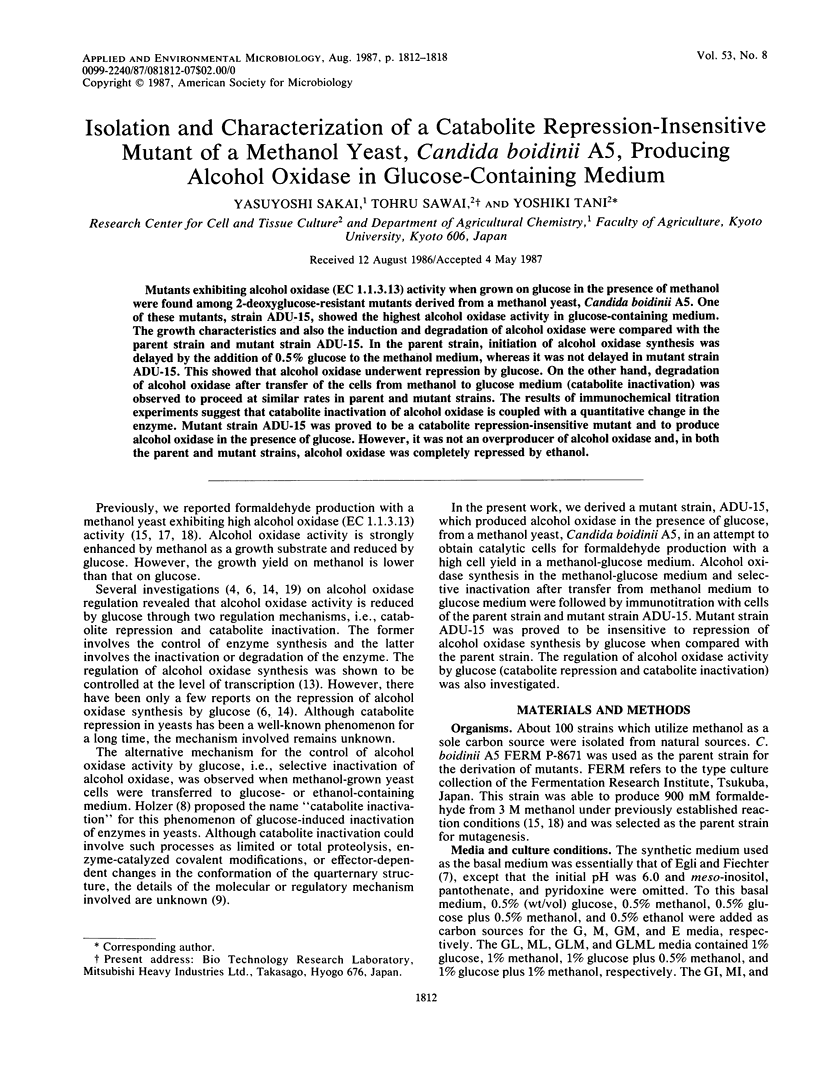Abstract
Mutants exhibiting alcohol oxidase (EC 1.1.3.13) activity when grown on glucose in the presence of methanol were found among 2-deoxyglucose-resistant mutants derived from a methanol yeast, Candida boidinii A5. One of these mutants, strain ADU-15, showed the highest alcohol oxidase activity in glucose-containing medium. The growth characteristics and also the induction and degradation of alcohol oxidase were compared with the parent strain and mutant strain ADU-15. In the parent strain, initiation of alcohol oxidase synthesis was delayed by the addition of 0.5% glucose to the methanol medium, whereas it was not delayed in mutant strain ADU-15. This showed that alcohol oxidase underwent repression by glucose. On the other hand, degradation of alcohol oxidase after transfer of the cells from methanol to glucose medium (catabolite inactivation) was observed to proceed at similar rates in parent and mutant strains. The results of immunochemical titration experiments suggest that catabolite inactivation of alcohol oxidase is coupled with a quantitative change in the enzyme. Mutant strain ADU-15 was proved to be a catabolite repression-insensitive mutant and to produce alcohol oxidase in the presence of glucose. However, it was not an overproducer of alcohol oxidase and, in both the parent and mutant strains, alcohol oxidase was completely repressed by ethanol.
Full text
PDF






Images in this article
Selected References
These references are in PubMed. This may not be the complete list of references from this article.
- BERGMEYER H. U. Zur Messung von Katalase-Aktivitäten. Biochem Z. 1955;327(4):255–258. [PubMed] [Google Scholar]
- Bormann C., Sahm H. Degradation of microbodies in relation to activities of alcohol oxidase and catalase in Candida boidinii. Arch Microbiol. 1978 Apr 27;117(1):67–72. doi: 10.1007/BF00689353. [DOI] [PubMed] [Google Scholar]
- Eggeling L., Sahm H. Direct Enzymatic Assay for Alcohol Oxidase, Alcohol Dehydrogenase, and Formaldehyde Dehydrogenase in Colonies of Hansenula polymorpha. Appl Environ Microbiol. 1980 Jan;39(1):268–269. doi: 10.1128/aem.39.1.268-269.1980. [DOI] [PMC free article] [PubMed] [Google Scholar]
- Eggeling L., Sahm H. Regulation of alcohol oxidase synthesis in Hansenula polymorpha: oversynthesis during growth on mixed substrates and induction by methanol. Arch Microbiol. 1980 Sep;127(2):119–124. doi: 10.1007/BF00428015. [DOI] [PubMed] [Google Scholar]
- Holzer H., Heinrich P. C. Control of proteolysis. Annu Rev Biochem. 1980;49:63–91. doi: 10.1146/annurev.bi.49.070180.000431. [DOI] [PubMed] [Google Scholar]
- Kominami E., Katunuma N. Studies of new intracellular proteases in various organs of rats. Participation of proteases in degradation of ornithine aminotransferase in vitro and in vivo. Eur J Biochem. 1976 Mar 1;62(3):425–430. doi: 10.1111/j.1432-1033.1976.tb10175.x. [DOI] [PubMed] [Google Scholar]
- Roggenkamp R., Janowicz Z., Stanikowski B., Hollenberg C. P. Biosynthesis and regulation of the peroxisomal methanol oxidase from the methylotrophic yeast Hansenula polymorpha. Mol Gen Genet. 1984;194(3):489–493. doi: 10.1007/BF00425563. [DOI] [PubMed] [Google Scholar]
- Sahm H., Wagner F. Mikrobielle Verwertung von Methanol. Eigenschaften der Formaldehyddehydrogenase und der Formiatdehydrogenase aus Candida boidinii. Arch Mikrobiol. 1973;90(3):263–268. [PubMed] [Google Scholar]
- Shimizu S., Shiozaki S., Ohshiro T., Yamada H. Occurrence of S-adenosylhomocysteine hydrolase in prokaryote cells. Characterization of the enzyme from Alcaligenes faecalis and role of the enzyme in the activated methyl cycle. Eur J Biochem. 1984 Jun 1;141(2):385–392. doi: 10.1111/j.1432-1033.1984.tb08203.x. [DOI] [PubMed] [Google Scholar]
- Veenhuis M., Van Dijken J. P., Harder W. The significance of peroxisomes in the metabolism of one-carbon compounds in yeasts. Adv Microb Physiol. 1983;24:1–82. doi: 10.1016/s0065-2911(08)60384-7. [DOI] [PubMed] [Google Scholar]
- Zimmermann F. K., Scheel I. Mutants of Saccharomyces cerevisiae resistant to carbon catabolite repression. Mol Gen Genet. 1977 Jul 7;154(1):75–82. doi: 10.1007/BF00265579. [DOI] [PubMed] [Google Scholar]



